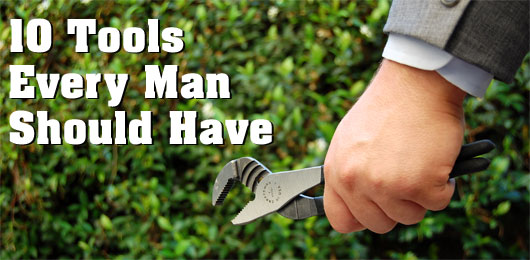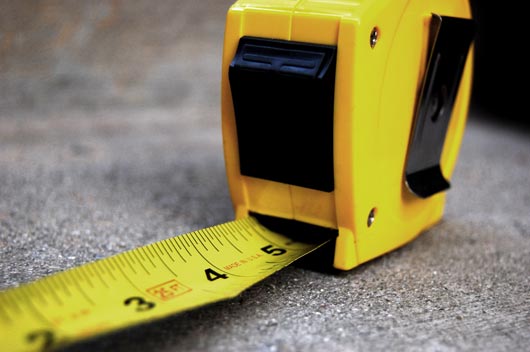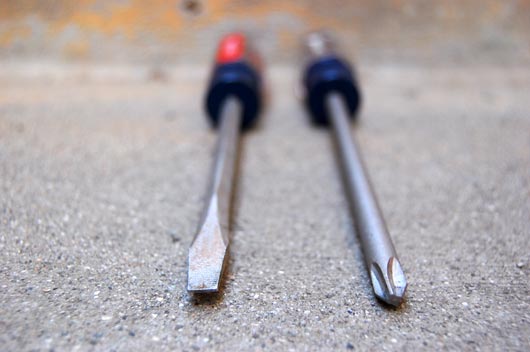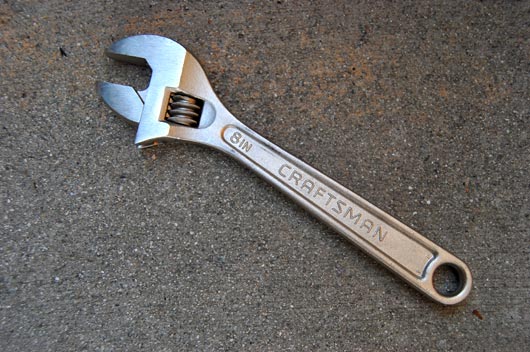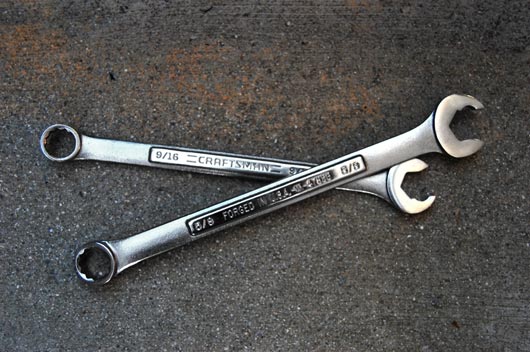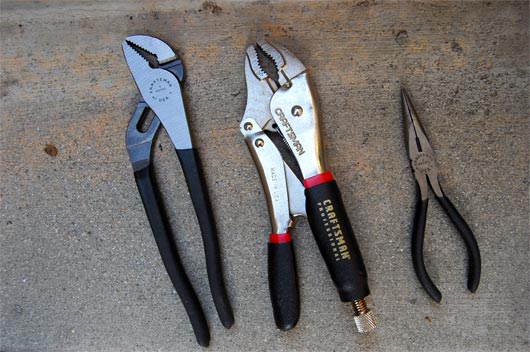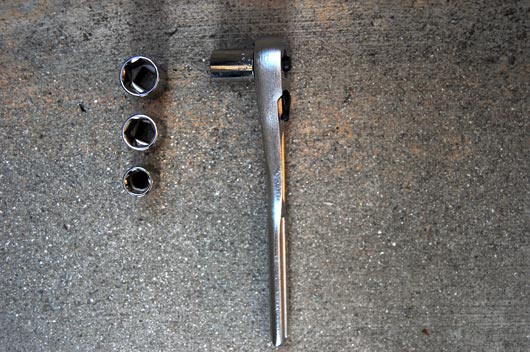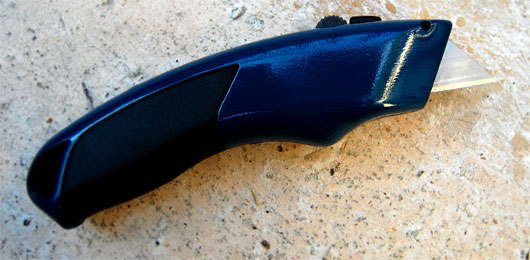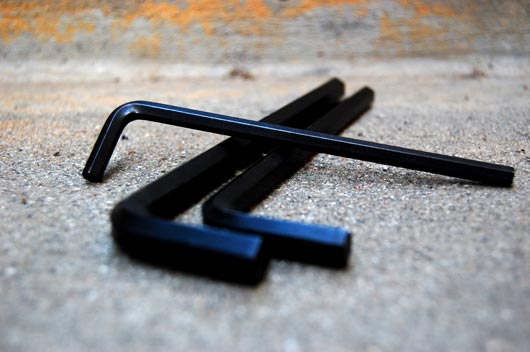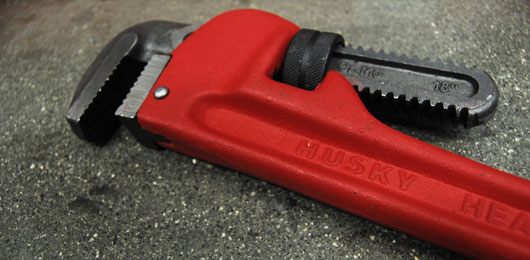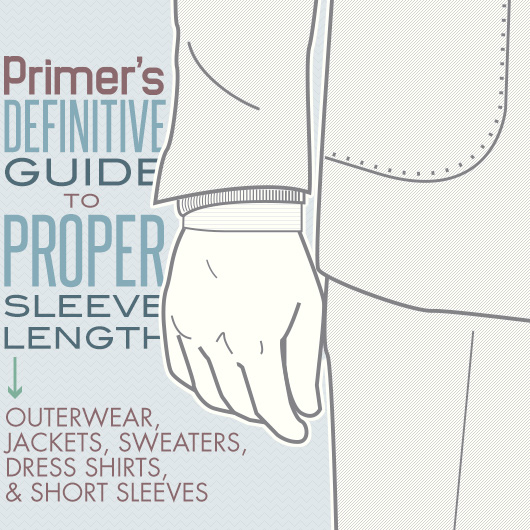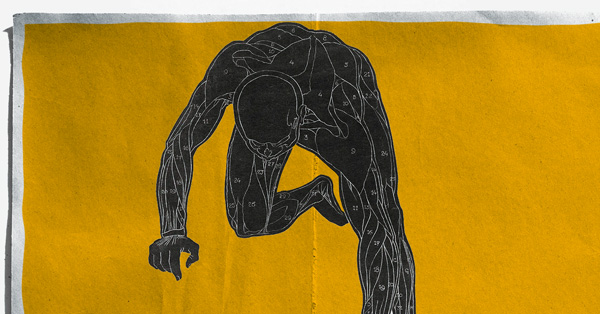By Jesse Stern
We're talking hand tools, here. This is Primer, not an Eli Roth movie. The tools are listed in order from most obvious to coolest, so as you read you should feel adrenaline mounting, blood surging to your head. Without further ado, in Exciting Countdown Style, here they are: the Ten Tools.
10. Tape Measure
While not an overtly macho tool, the tape measure is the device behind the “measure twice, cut once” adage. This can also be rephrased “measure twice, buy once”, or “two measurements, one trip to the paint store.” Unless you are sewing, or doing an arts & crafts project, using a yardstick is totally lame. So get a 25′ tape and start measuring.
Painting walls? Height times Width equals Area. (This will tell you how much paint to buy.) Want to know if that new ski rack will clear the roof of your garage, or if that new futon couch will fit next to the kitchen table? The answer is in the tape.
9. Screwdriver
This one is pretty obvious. Screwdrivers are as much a part of our daily lives as espresso and NASCAR racing. What's not so obvious is that you need a few different sizes. Using the wrong size screwdriver causes slipping. Slipping ruins both the screw and the head of the screwdriver, and the ensuing frustration is guaranteed to show people your ugly side.
While there are many head types, the only ones you need are slotted / flat head and Phillips. Get two sizes for each head type. I think the sizes are designated #0 (tiny) thru #4 (pretty darn big). You want #2 and #3, but just ask for the two most common sizes.
Note: If you are the youngest child in a large family, buying a huge, slotted screwdriver may help suppress your feelings of inadequacy.
Extra Credit: If you own glasses, musical instruments, or like to play with gadgets, such as hard drives, then get a set of jewelry screwdrivers. These are about 3″ long, with a convenient swivel on the handle's end. Keep them in the box, or you will lose them.
8. Hammer
Again, this one is so obvious it barely needs explanation. Hammers have many uses, even for the non-handyman. Feeling artsy? Pound a nail into the wall and hang up a picture. Feeling angry? There's no vent like busting a hole in your apartment's drywall. (In a later issue, we'll show you how to get your whole damage deposit back with minimum effort.) You can even use them on some cars to tighten the alternator belt.
There are several varieties of hammer. Unless you're in construction or doing metal work, a simple wooden-handled claw hammer is all you need. Get one, if only because it looks really stupid trying to hammer nails with the handle of a screwdriver.
7. Crescent (Adjustable) Wrench
If you only own one wrench, this is it. It has a little adjuster that you move with your thumb. Don't bother trying to remember which way tightens and which way loosens the wrench. You will always turn it the wrong way first, chuckle at your own forgetfulness, then turn it the right way. A 1″ crescent wrench should take care of most jobs. A bigger wrench may also be handy for larger nuts/bolts.
To use, simply tighten the wrench down onto your nut or bolt. Make it as tight as possible, to avoid slipping, which wears out, or “dog ears,” the nut. While not as important a rule to remember as on the pipe wrench (see below), the solid, non-moving end should be behind the direction you're turning. Let's call this the Back Away rule.
Note: After use, always tighten your wrench until it is completely closed; this shows any woman who might examine your toolbox that you are thorough and caring.
6. Box/Open-end Wrench Set
Box-end and open-end wrenches are the bread-and-butter of the wrench family. Simple, yet effective, they are a class above the crescent wrench. Each wrench has a fixed size, so you won't damage your nuts (ouch), and they are small enough to fit into tight spaces.
The most useful variation, known as a combination wrench, has a box on one end (i.e. a closed ring), and is open on the other. A typical set usually ranges from somewhere around 7/16″ to 3/4″ SAE or, in Metric sizes 7mm to 16mm. A Metric set will probably give you the most bang for your buck, but if you're feeling frisky, get both.
Note: Even many American cars have parts made elsewhere, using Metric-sized nuts and bolts. For best results, try to figure out which system is being used, and use the right set of wrenches for the job.
5. Pliers (Channel Lock, Vice Grips, Needle-Nose)
The plier family is full of cousins and step-brothers. Unlike actual cousins and step-brothers, however, all members of the plier family serve distinct and useful purposes. The most important ones are vice grips (AKA locking pliers) and needle-nose pliers.
Needle-nose pliers are useful for precise jobs, and include a handy wire cutter. Though these two will serve you well, you should eventually get basic adjustable-joint pliers, and a Channel lock (big adjustable-joint pliers).
Extra Credit: If you do any electronic or electrical work, you'll also want a wire stripper. This is different than a wire cutter because, as the name suggests, it strips the coating from the wire, while leaving the wire intact.
4. Socket Wrench
Besides being great for working on cars, socket wrenches are just plain cool. The ratchet makes a satisfying click when you turn it, which is bound to expand your sphere of Alpha Male influence. Get a decent wrench with a 3/8″ drive, and a basic set of both Metric and SAE (American) socket sizes. An extender is also handy for tight spots.
Make sure you know how to use a socket wrench, before you invite ridicule by trying to use it incorrectly. Pop the socket onto the handle (square peg to square hole — that's it). Now, the back of the wrench has a little lever on it. The lever should be set into position by turning it the OPPOSITE direction of the way you want to turn your nut or bolt. Want to tighten? Turn the lever counter-clockwise. Want to loosen? Turn the lever clockwise. Got it? Good.
Extra Credit: Get a spark plug socket. These are deeper than normal, to reach the hex on your plugs. Since spark plugs come in a variety of sizes, make sure you get the right size. Also, you will probably need an extender to get your ratchet handle to turn past the engine block. If your car is a go-cart or a lawn edger, never mind about the extender.
3. Utility Knife
This tool has one job, and it does it well: it cuts things. Good for slicing linoleum, plastic, rubber, packing tape, toy dinosaurs, shower curtains, even paper. Trust me, you don't want to diminish the joy of buying a brand new 42″plasma TV by cutting the box open with a steak knife. That would be lame. Oh, and you might cut your merchandise.
2. Allen Wrench Set
Also known as Allen keys or hex wrenches, these little L-shaped doodads are a bit specialized. They are essential for working on bicycles, and you may need a couple of them if you want to adjust the neck on your guitar or bass. If you ever buy furniture that you need to put together yourself, you're going to need Allen wrenches. Nothing challenges your manhood like not being able to put together the stand for your new plasma or worse–your girlfriend's new dresser.
You can also use an Allen wrench to manually turn your stuck garbage disposal, which may help dislodge whatever it was that you shouldn't have put down there in the first place.
Note: Do not, I repeat DO NOT, adjust the neck on your guitar or bass unless you really know what you're doing. Though adjusting the truss rod is not rocket science, it's pretty easy to permanently damage the neck of your instrument. If you want to learn how to do this, let me know. I can help!
1. Pipe Wrench
As we near the end of this exciting countdown, let's take a moment to enjoy the newfound weight of our toolbox. Grip the handle, feel its heft. Now, prepare for the added heft, the manly color, and the singular use of … El Numero Uno, Tool #1: The Pipe Wrench.
My opinions on this tool have already been published. Nevertheless, I will repeat: The Pipe Wrench is the most manly hand tool on the planet. It's huge, heavy, painted the color of a fire engine, has massive jaws and jagged teeth. So awed am I by this tool that I shall refer to it as a specific Person, Place or Thing. The Pipe Wrench.
In case you missed my earlier rant, the Pipe Wrench looks exactly like the murder weapon in the board game Clue. It has one basic purpose, elucidated in its name. It's a wrench that you use on pipes. It's also handy for pipe fittings.
To use, clamp down and turn. Remembering the Back Away rule is especially important when dealing with the Crouching Tiger Hidden Dragon of the wrench family: The closed end should be behind whichever direction you're turning. Thus, if you're pushing, you should see the closed end. If you're pulling, you should see the open end. This is how the Pipe Wrench is designed. Note: Though its weight is enticing, do not use the Pipe Wrench as a hammer. Do not anger the Pipe Wrench, for great is its wrath.
Tip of the Week: Give Them a Home
Once you have your toolbox, you will start finding more and more uses for the tools in your toolbox. That's right, I said “in your toolbox”, not “under the sink”, “in your car”, or “wherever you did your last fix-it project”. Nothing says “waste of time” like looking for tools when you need them. Not only that, your tools are valuable. Losing a screwdriver, or one socket from a set, is not only annoying; it adds up fast. Good tools are meant to last a lifetime. Keep them clean, dry, and within reach. That's what the toolbox is for. Get yourself in the habit of returning your tools to your toolbox, as soon as you finish the job. Your tools — and your wallet — will thank you for it.



